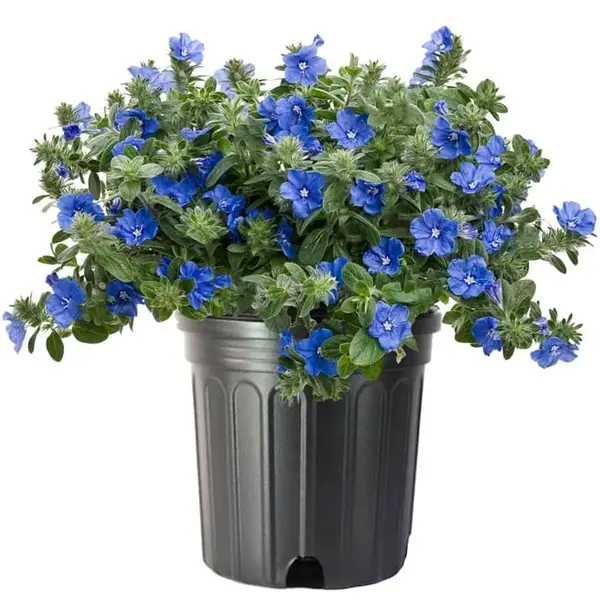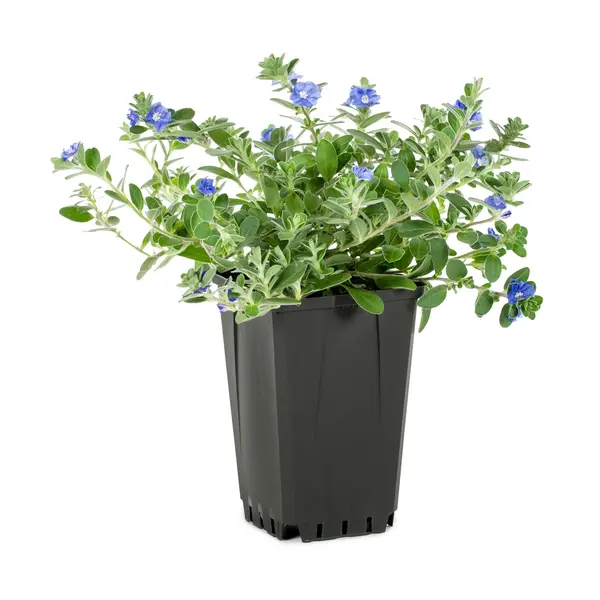Blue Daze, Evolvulus glomeratus, Dwarf Morning Glory
₹465.00 Original price was: ₹465.00.₹149.00Current price is: ₹149.00.
Out of stock
Email when stock available
Selling size: Single Plant | 2.5″ Pot Included | Secure Packing
Disclaimer: It is a sensitive plant that may be damaged during transit if a delay happens and is not recommended for northern, eastern and western India.
Blue Daze (Evolvulus glomeratus), also known as Dwarf Morning Glory, is a charming, low-growing plant prized for its vibrant blue flowers and silvery-green foliage. It’s relatively low-maintenance, especially in warm climates, making it a popular choice for ground cover, hanging baskets, and container gardens.

Here’s a comprehensive guide to Blue Daze, Evolvulus glomeratus, Dwarf Morning Glory plant care:
1. Sunlight:
- Full Sun is Key: Blue Daze thrives in full sun, meaning it needs at least 6-8 hours of direct, unfiltered sunlight daily. This is crucial for abundant flowering and maintaining its compact, bushy form.
- Partial Sun Tolerance: While it can tolerate partial sun (some direct sun mixed with shade), extended periods in lower light can lead to leggy growth, fewer blooms, and a duller foliage color.
2. Soil:
- Well-Draining is Essential: This is perhaps the most critical factor. Blue Daze absolutely hates soggy soil, which can quickly lead to root rot. Ensure your soil drains exceptionally well.
- Soil Type: It’s quite adaptable to various soil types, including sandy soils, but prefers a slightly acidic to neutral pH (around 5.5 to 7.0). Loamy soil with good drainage is ideal.
- Mulch: A light layer of organic mulch can help regulate soil temperature and retain moisture, but keep it away from the plant’s base to prevent excess moisture.
3. Watering:
- Consistent Moisture (but not soggy): While young and establishing, water regularly to keep the soil consistently moist.
- Drought Tolerant Once Established: Once mature, Blue Daze becomes quite drought-tolerant. Allow the top few inches of soil to dry out completely between waterings.
- Avoid Overwatering: Overwatering is a common killer of Blue Daze. Always check the soil moisture before watering.

4. Temperature and Humidity:
- Heat Lover: Blue Daze absolutely loves warmth and thrives in hot, humid conditions. It performs best in temperatures above 18∘C (65∘F).
- Frost Sensitivity: It is a tender perennial, hardy in USDA Zones 9-11. In colder zones, it’s typically grown as an annual and will not tolerate frost. If you’re in a colder climate and want to keep it over winter, you’ll need to bring it indoors or take cuttings.
- Indoor Growing: If growing indoors, place it near a sunny window and ensure good air circulation.
5. Fertilizing:
- Monthly During Growing Season: During spring and summer (the active growing season), feed your Blue Daze monthly with a balanced liquid fertilizer (e.g., 10-10-10) according to the product’s instructions.
- Slow-Release Option: Alternatively, you can use a slow-release granular fertilizer once or twice a season.
- Avoid Excess Nitrogen: Too much nitrogen can promote leafy growth at the expense of flowers. If you notice leggy growth with few blooms, cut back on nitrogen and consider a potassium-based fertilizer to encourage flowering.
- No Winter Feeding: Do not fertilize during winter if growing as a perennial in warmer climates.
6. Pruning:
- Promote Bushiness: When the plant is young, pinch back the growing tips to encourage branching and a bushier, more compact shape.
- Address Legginess: If the plant starts to look scraggly or leggy during the season, a light pruning will stimulate new growth and more blooms. You can cut it back to a desirable size.
- Self-Cleaning: Blue Daze is self-cleaning, meaning you don’t need to deadhead spent blooms. They typically fall off on their own.
7. Pests and Diseases:
- Generally Resistant: Blue Daze is quite resistant to most common pests and diseases.
- Root Rot: The main issue to watch out for is fungal problems like root rot, almost always caused by overwatering or poorly draining soil.
- Occasional Pests: Occasionally, you might encounter fungus gnats or shore flies, but these are usually minor issues. Neem oil can be used if an infestation occurs.
8. Propagation:
- Stem Cuttings: Blue Daze can be easily propagated from semi-hardwood stem cuttings in spring or summer. Take 3-5 inch cuttings, remove lower leaves, dip in rooting hormone (optional), and plant in a well-draining potting mix. Keep moist and in bright, indirect light until roots develop.
- Seeds: You can also propagate from seed indoors just before the last frost.

9. Uses in the Garden:
- Groundcover: Its low-growing, spreading habit makes it an excellent groundcover, forming a dense mat of foliage.
- Containers and Hanging Baskets: Its trailing stems are perfect for cascading over the edges of pots, window boxes, and hanging baskets.
- Edging: Great for defining beds and borders.
- Pollinator Attractor: Its blue flowers attract butterflies and bees.
- Drought-Tolerant Landscaping: A good choice for xeriscaping or areas where water conservation is a priority.
By following these care tips, you can enjoy the beautiful, sky-blue blooms of Blue Daze throughout the warm season!
| Weight | 1 kg |
|---|
Only logged in customers who have purchased this product may leave a review.
Related products
-
Philodendron Burle Marx Plant
₹485.00Original price was: ₹485.00.₹149.00Current price is: ₹149.00.Add to cartSelling size: Single plant | Pot Included Best Indoor Plant 🌿👌 Care is not required. It will grow both in soil and water. Philodendron Burle Marx is great for people who like extraordinary evergreen houseplants. Besides, it isn’t a demanding plant. All it needs is enough filtered light, moderate room temperatures (from 60 to 75 …
-
Philodendron Mexicanum
₹1,090.00Original price was: ₹1,090.00.₹749.00Current price is: ₹749.00.Add to cartSelling size: Single Plant | Pot included The Philodendron mexicanum is a beautiful vining plant known for its long, arrow-shaped leaves with a striking deep maroon or reddish underside. As its name suggests, it is native to the tropical forests of Mexico. It’s a relatively easy-to-care-for plant, especially for those familiar with other vining philodendrons. …
-
Philodendron Xanadu
₹450.00Original price was: ₹450.00.₹175.00Current price is: ₹175.00.Rated 5.00 out of 5Add to cartSelling size:Well rooted plant | 2.5″ Pot Included Winter Orchid Requirements: Growing Orchids During Winter It will form a dense clump of beautifully lobed leaves and will tend to grow wider than taller. The Xanadu philodendron houseplant can grow to 2 to 4 feet tall (0.6 to 1.2 m.) and up to 4-6 feet (1.2 …
-
Pilea Repens, Black Panamiga
₹280.00Original price was: ₹280.00.₹129.00Current price is: ₹129.00.Rated 5.00 out of 5Add to cartSize: Single Plant | Jiffy Bag Caring for a Pilea Ripens (also known as Black Panamiga) involves understanding its specific needs to ensure it thrives. Here’s a breakdown of Pilea Repens, Black Panamiga key care aspects: Key Care Points: Light: Pilea repens prefers bright, indirect sunlight. Direct sunlight can scorch its leaves. Rotating the plant …
-
Dischidia Ruscifolia (Million Hearts)
₹695.00Original price was: ₹695.00.₹375.00Current price is: ₹375.00.Add to cartPlant Size: Single plant | 2.5″ Pot Included | Free Shipping The Dischidia ruscifolia, commonly known as the Million Hearts plant, is a delightful and easy-to-care-for trailing epiphyte. Its name comes from the abundance of small, heart-shaped leaves that densely cover its slender stems. As a member of the same family as Hoyas, its …
-
Dischidia nummularia (Pebble Beach/ Button Orchid)
₹655.00Original price was: ₹655.00.₹375.00Current price is: ₹375.00.Rated 5.00 out of 5Add to cartPlant Size: Single plant | 2.5″ Pot Included | Free Shipping he Dischidia nummularia, commonly known as the String of Nickels, Pebble Beach plant, or Button Orchid, is a charming epiphyte with trailing stems covered in small, round, succulent-like leaves. It’s a great choice for hanging baskets and is known for being relatively easy to …
-
Chlorophytum Spider Live Plant
₹249.00Original price was: ₹249.00.₹49.00Current price is: ₹49.00.Add to cartSelling size: Well rooted Single plant | 2.5″ Pot included Chlorophytum Spider, also the Spider Plant is an impressive houseplant which is the perfect plant for any beginner. A NASA certified air purifier, its long, green foliage with white variegations look good in both hanging planters and as desktop setups. In favourable conditions, it blooms …
- Today's Offer322322 products
- Shop All12291229 products
- Featured Collections12121212 products
- MOSSES11 product
- AIR PLANTS77 products
- BEGINNER FRIENDLY582582 products
- BONSAI3737 products
- CREEPERS280280 products
- FLOWERING PLANTS290290 products
- FOLIAGE PLANTS858858 products
- FRUIT PLANTS1515 products
- GIFTING PLANTS189189 products
- HANGING PLANTS373373 products
- MEDICINAL PLANTS66 products
- PET FRIENDLY PLANTS371371 products
- RARE PLANTS622622 products
- STRINGS SUCCULENTS3737 products
- SUCCULENTS113113 products
- TERRARIUM PLANTS479479 products
- TREE7171 products
- VARIEGATED PLANTS220220 products
- VEGITABLES55 products
- WATER PLANTS3030 products
- Plants By Size12031203 products
- Plants By Price836836 products
- Under ₹99148148 products
- Under ₹199203203 products
- Under ₹299418418 products
- Under ₹399494494 products
- Under ₹599627627 products
- Under ₹999813813 products
- Plants By Variety11311131 products
- Aralia55 products
- Cryptanthus44 products
- Medinilla11 product
- Adenium2222 products
- Aglaonema3232 products
- Alocasia & Colocasia5454 products
- Altheranthera11 product
- Anthurium9292 products
- Baby Sunrose22 products
- Bamboo33 products
- Banana Variegated55 products
- Begonia33 products
- Bougainvillea1414 products
- Bromeliads22 products
- Cactus1616 products
- Caladium2121 products
- Calatheas & Marantas4545 products
- Carnivorous1212 products
- Costus55 products
- Croten44 products
- Dischidia88 products
- Dracenia99 products
- Drimiopsis33 products
- English Ivy44 products
- Episia33 products
- Ferns7676 products
- Euphorbia1111 products
- Fittonia66 products
- Grass33 products
- Haworthia22 products
- Heliconias44 products
- Homalomena1616 products
- Hoya1313 products
- Ixora22 products
- Jade22 products
- Labisia1414 products
- Lipstick plants1010 products
- Monstera5353 products
- Orchids4444 products
- Coelogyne Rochussenii Fragrance Orchid11 product
- Dendrobium Orchid1010 products
- Mokara Orchids1717 products
- Mokara Orchid (Matured Plant)1414 products
- Mokara Orchids (Special Varietys)33 products
- Phalaenopsis, Moth orchid1616 products
- Oxalis Triangularis/ Butterfly Plant55 products
- Palm88 products
- Peace Lily77 products
- Pedilanthus88 products
- Pelliona Repens33 products
- Pepperomia1515 products
- Petrea44 products
- Philodendron153153 products
- Pilea66 products
- Pine22 products
- Piper2121 products
- Pothos & Scindapsus3232 products
- Rubber plants88 products
- Schismatoglottis77 products
- Snake plants77 products
- Syngonium4444 products
- Spider plants1313 products
- Tapioca33 products
- Thunbergia77 products
- Torenia77 products
- Tradescantia Varietys1111 products
- Zz Plants55 products
- Other plants163163 products
- Plants By Location549549 products
- Balcony plants470470 products
- Bedroom plants118118 products
- Kitchen plants9898 products
- Livingroom plants137137 products
- Office plants124124 products
- Outdoor plants303303 products
- Restroom plants8282 products
- Best Sellers6868 products
- Combo Offers1616 products
- Garden Accessories3737 products
- Bulbs And Tubers88 products
- Fertilizers11 product
- Insecticide11 product
- Planters55 products
- Pot Hanger88 products
- Potting Mix33 products
- Seeds1313 products












 If you need any assistance, I'm always here. Have you found what you were looking for?
If you need any assistance, I'm always here. Have you found what you were looking for?
Reviews
There are no reviews yet.